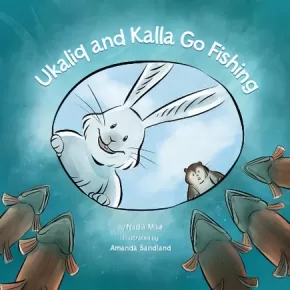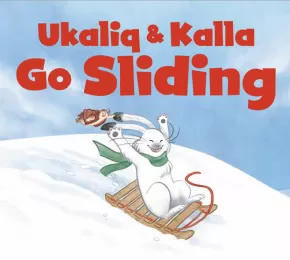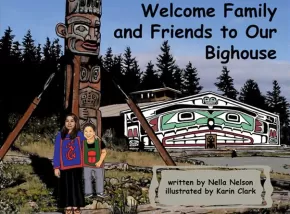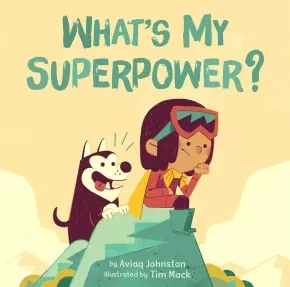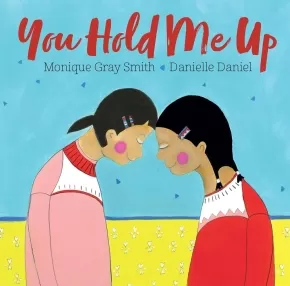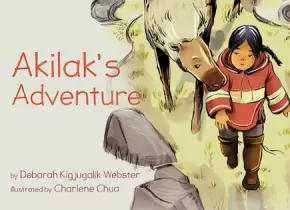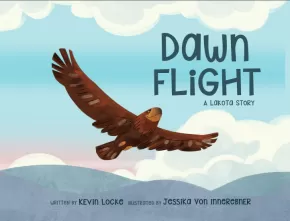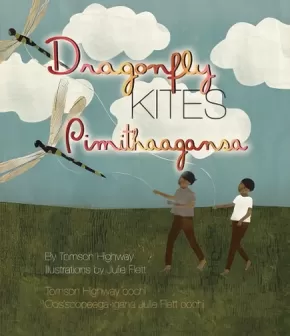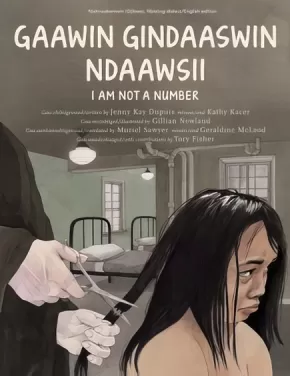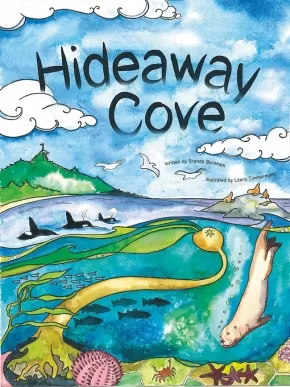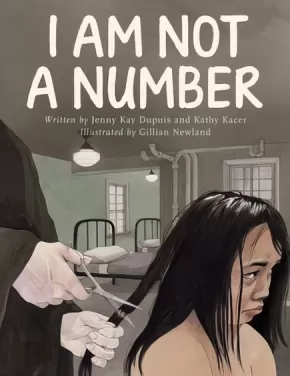
Picture Books
571
-
585
of
752 Results;
Sort By
Go To
of 51
Ukaliq and Kalla Go Fishing
$16.95
Artists:
Format:
Hardcover
Text Content Territories:
Indigenous Canadian; Inuit;
Grade Levels: Preschool; Kindergarten;
ISBN / Barcode: 9781772271355
Synopsis:
Synopsis:
Ukaliq and Kalla are two friends who could not be more different.
Ukaliq is loud, excited, and always looking for adventure. Kalla on the other hand, is calm, quiet, and knows it’s best to be well prepared before travelling out on the land or sea ice.
When the two friends head out for a day of fishing, Ukaliq can barely wait to get his line in the water - but his eagerness to catch a fish may just leave him empty handed in the end.
There is a lot Kalla could teach Ukaliq about a successful fishing trip, if only Ukaliq would sit still long enough to listen!
Review
"Ukaliq and Kalla Go Fishing is a classic story of two friends who are complete opposites... What makes this story unique is the setting and the dynamic between the characters. The story takes place in the Arctic, a setting which provides surroundings, animals, and terminology that children may not be familiar with (for example, the animals 'snow bunting' and 'char', and words like 'qamutiik' and 'jerry can'). Fortunately, the majority of new words can be figured out in context and through examination of the pictures." — CM Magazine
Additional Information
36 pages | 8.75" x 8.75"
Ukaliq and Kalla Go Sliding - Nunavummi Reading Series
$8.95
Artists:
Format:
Paperback
Text Content Territories:
Indigenous Canadian; Inuit;
Grade Levels: 2;
ISBN / Barcode: 9781774501948
Synopsis:
Synopsis:
Best friends Ukaliq and Kalla are about to go on an outdoor adventure, sliding at the park!
This book uses a humorous sequential story to teach children about outdoor safety.
Educator Information
This book is part of the Nunavummi Reading Series, a Nunavut-developed series that supports literacy learning while teaching readers about the people, traditions, and environment of the Canadian Arctic. Ukaliq and Kalla Go Sliding is a Level 9 book in the Nunavummi series.
Nunavummi Reading Series books have also been officially levelled using the Fountas & Pinnell Text Level Gradient™ Levelling System. Ukaliq and Kalla Go Sliding's F&P Level is G.
Recommended for ages 5-7.
Additional Information
28 pages | 8.00" x 6.00"
Welcome Family and Friends to Our Bighouse
$21.95
Artists:
Format:
Paperback
Text Content Territories:
Indigenous Canadian; First Nations; Kwakwaka'wakw (Kwakiutl);
ISBN / Barcode: 9780973676990
Synopsis:
Synopsis:
This contemporary story is told through the voice of a 12-year-old Kwakwaka’wakw girl named Gana, who lives in ‘Yalis (Alert Bay, BC). From the time she is little, Gana attends Potlatches and ceremonies in the Bighouse. The regalia she wears—a button blanket, dancing apron and masks—were designed and made for her based on her family origins or clans. The ancient cultural teachings she learns in the Bighouse are useful to Gana in her everyday life and continue to have value in the 21st century.
• Full colour illustrations showing aboriginal masks and regalia in context
• Contains some Kwak’wala words with meaning and pronunciation guides
• 11” x 8.5” soft cover, 96 pages
Nella Cook Nelson, originally from the N’amgis Nation, was born and raised in Alert Bay, B.C. It wasn’t until Nella was in grade 4 that integration occurred and aboriginal students were allowed to attend the public schools. When she was 12-years-old, the first Bighouse since the anti-potlatch law had been lifted was built in Alert Bay.
Nella attended both Camosun College and the University of Victoria. When she started teaching in public schools in 1979, aboriginal content didn’t exist. After 11 years teaching, she has coordinated the Victoria School District’s Aboriginal Nations Education Division for 27 years. She serves on Provincial, college, university, community boards and advisory committees to improve aboriginal health, safety and education.
Nella has recieved the Queen’s 125 Commemorative Medal, YM/YWCA Women of Distinction, Camosun’s Distinguished Alumni, and Excellence in Cultural Heritage & Diversity Awards.
What's My Superpower?
$18.95
Artists:
● Tim Mack
Format:
Hardcover
Text Content Territories:
Indigenous Canadian; Inuit;
ISBN / Barcode: 9781772271409
Synopsis:
Synopsis:
Nalvana feels like all of her friends have some type of superpower. She has friends with super speed (who always beat her in races), friends with super strength (who can dangle from the monkey bars for hours), and friends who are better than her at a million other things.
Nalvana thinks she must be the only kid in town without a superpower.
But then her mom shows Nalvana that she is unique and special—and that her superpower was right in front of her all along.
Awards
- 2017 Canadian Children's Book Centre Best Books for Kids and Teens
Reviews
“. . . [W]ell-written, [and] heart-warming . . .” — Quill & Quire
“Nalvana is a bundle of creativity, spunk, and determination—readers will be happy to know her.” — Kirkus
“. . . [A] very sweet story that encourages children to rethink how they evaluate success . . .” — The Book Wars
“. . . Nalvana’s superpower is not one of the athletic or other overt skills that are normally so admired in our current society . . ., Aviaq Johnston has made her story one of inclusivity, not exclusivity.” — CanLit for Little Canadians
“. . . [A] book kids will clamor to read, even as they learn terms like ‘anaana’, ‘inuksuk’, and ‘panik’. That’s its superpower.” — School Library Journal
Educator Information
An Inuktitut Glossary consisting of four words is included at the back of the book.
Recommended ages: 3-5
This book has been officially levelled using the Fountas & Pinnell Text Level Gradient™ Levelling System. Its F&P level is L.
This book is available in a revised board book edition: What's My Superpower? (BB)
Additional Information
36 pages | 8.75" x 8.75"
You Hold Me Up (HC)
$21.95
Artists:
Format:
Hardcover
Text Content Territories:
Indigenous Canadian;
ISBN / Barcode: 9781459814479
Synopsis:
Synopsis:
Encourage children to show love and support for each other and to consider each other’s well-being in their everyday actions.
Consultant, international speaker and award-winning author Monique Gray Smith wrote You Hold Me Up to prompt a dialogue among young people, their care providers and educators about reconciliation and the importance of the connections children make with their friends, classmates and families. This is a foundational book about building relationships, fostering empathy and encouraging respect between peers, starting with our littlest citizens.
Reviews
"Smith's text is heartwarming! And the illustrations, by Danielle Daniel, reflect Native people in the present day. Like My Heart Fills with Happiness, this new book by Smith is one that parents, grandparents, pre-school and elementary teachers, and librarians, will want to have on their shelves." — Debbie Reese, American Indians in Children's Literature
"People of all ages can find something of value within the pages of Monique Gray Smith and Danielle Daniel's book…Smith has Cree and Lakota ancestry, while Daniel is Métis. With this book, they become quiet and understated—yet powerful—voices in an age of reconciliation. You Hold Me Up is simple, yet beautiful, subtle but thought-provoking. It contains critical messages about love, unity, and support. Through carefully chosen words and strong, colourful are, the book presents an important reminder to readers to sustain and support one another. Highly Recommended." — CM Magazine
"Perfect for a shared storytime as well as a lap-sit reading session, the actions of each person emphasize community, togetherness, and mutual respect. While sharing is a universal concept, Daniel's illustrations bring specificity to the narrative…Just as in Smith's board book My Heart Fills with Happiness, readers will joyfully make connections between their own communities and the indigenous one depicted here." — IndiePicks Magazine
"You Hold Me Up is a rhythmic story that reinforces for young readers about reconciliation and the importance of the connections children make with others. The story aims to encourage children to build relationships, foster empathy and encourage respect between peers while considering each other’s well-being in their everyday actions." — The Dalai Lama Center
Educator Information
Recommended for ages 3 to 5.
This book is available in English and Plains Cree: You Hold Me Up / ê-ohpinitoyahk
This book is available in English and Anishinaabemowin: You Hold Me Up / Gimanaadenim
This book is also available in French: Tu es là pour moi
This book is available in a board book format for younger audiences: You Hold Me Up (BB)
Additional Information
32 pages | 9.00" x 9.00"
Akilak's Adventure
$10.95
Artists:
Format:
Hardcover
Text Content Territories:
Indigenous Canadian; Inuit;
ISBN / Barcode: 9781772271232
Synopsis:
Synopsis:
When Akilak must travel a great distance to another camp to gather food, she thinks she will never be able to make it. With a little help from her grandmother’s spirit, and her own imagination to keep her entertained, Akilak manages to turn a long journey into an adventure. Even though she at first feels that she will never be able to reach her destination, she keeps her grandmother’s assurance that her “destination is not running away; it will be reached eventually” in mind and ends up enjoying the journey that at first seemed so daunting.
Reviews
“Akilak’s Adventure is a worthy addition to school and public library collections.” — CM Magazine
“An engaging and recommended read-aloud for all collections.” — School Library Journal
“Akilak’s Adventure has timeless teachings about responsibility and the importance of imagination to make it a worthwhile read now and always.” — CanLit for Little Canadians
Additional Information
32 pages | 9.00" x 7.00"
Animals of the Salish Sea (HC)
$18.00
Artists:
Format:
Hardcover
Text Content Territories:
Indigenous Canadian; First Nations; Salish; Coast Salish;
ISBN / Barcode: 9781554762057
Synopsis:
Synopsis:
Animals of the Salish Sea is a wonderful new book for home and school. This book shares Coast Salish traditional teachings of 26 animals. Also included is the specific aspects of each animal who live in this unique marine environment.
Explore the Salish Sea through the First Nations and Native art of Coast Salish artists (including: Terry Horne, Doug LaFortune, Francis Horne Sr., Maynard Johnny Jr., Marissa Nahanee, Latash Nahanee, Simone Diamond, Erica Joseph, Darrell Thorne, Doug Horne, Chad Leon, Joe Sxwaset-Wilson) and Musqueam, Coast Salish author Melaney Gleeson-Lyall.
"The Coast Salish people have been the guardians of the Salish Sea for thousands of years. The Salish Sea provides us food and sustenance for living, ceremonies, and journeys of life. We use the Salish Sea as our highway to travel and visit all of our relations. Our cedar plank longhouses lined the shores inviting all of our visitors to our lands." - Doug LaFortune, Coast Salish
Educator Information
This beautiful and colourful book offers teachings about the animals of the Salish Sea!
Additional Information
Hardcover
Dawn Flight: A Lakota Story
$16.99
Artists:
Format:
Paperback
Text Content Territories:
Indigenous American; Native American; Sioux; Lakota; Indigenous Canadian; First Nations; Sioux; Lakota;
ISBN / Barcode: 9780993869426
Synopsis:
Synopsis:
Long ago, when a great flood cleansed the land of unhappiness, the Grandfather sent Wanjblí the eagle to save one virtuous member of the human race and teach her how to live a good life. The eagle is a powerful symbol of courage, wisdom, and strength. In Kevin’s book he shares an inspiring vision of unity and hope for a new generation teaching children to recognize the eagle in themselves and others and always to soar above the darkness into the light.
Educator Information
This resource is also available in French: L’Envol de L’Aube: Un Récit Lakota
Additional Information
40 pages | 8.50" x 11.00"
Dragonfly Kites
$14.95
Artists:
Format:
Paperback
Text Content Territories:
Indigenous Canadian; First Nations; Cree (Nehiyawak);
ISBN / Barcode: 9781897252642
Synopsis:
Synopsis:
Dragonfly Kites is the third book in Tomson Highway's magical Songs of the North Wind trilogy. Like Fox on the Ice and Caribou Song, it has a bilingual text, written in English and Cree. And once again Tomson Highway brilliantly evokes the very essence of childhood as he weaves a deceptively simple story about the power of the imagination.
Joe and Cody, two young Cree brothers, along with their parents and their little dog Ootsie, are spending the summer by one of the hundreds of lakes in northern Manitoba. Summer means a chance to explore the world and make friends with an array of creatures, But what Joe and Cody like doing best of all is flying dragonfly kites. They catch dragonflies and gently tie a length of thread around the middle of each dragonfly before letting it go. Off soar the dragonflies into the summer sky and off race the brothers and Ootsie too, chasing after their dragonfly kites through trees and meadows and down to the beach before watching them disappear into the night sky. But in their dreams, Joe and Cody soar through the skies with their kites until it's time to wake up.
Reviews
"Unlike most fiction, Dragonfly Kites does not follow a standard plot line. Like the dragonfly kites that the boys follow, the plot simply glides along until the boys wake up from their dream. This is appropriate due to the significance the illustrations play in this picture book, as well as the age of the intended audience. Readers are not overwhelmed by the storyline and are free to appreciate the accompanying illustrations. The illustrations in Dragonfly Kites act as an extension of the story. The pictures in the book are colourful, beautiful, and have an austere, stark quality. This is consistent with other works produced by award-winning illustrator Julie Flett. This style suits the story as, aside from the nature that surrounds around them, Joe and Cody are depicted as being by themselves. While they live with the parents, their adventures occur when their parents are fishing without them. The full-page illustrations demonstrate the vast space that surrounds the boys." — CM Magazine
"At once a celebration of heritage, the wilderness, and imagination, this book is a breath of fresh northern air." — Kirkus Reviews
Educator & Series Information
This is the third book in the Songs of the North Wind series, a dual-language (English and Cree) series about two young Cree boys.
This book is available in French/Cree: Les libellules cerfs-volant/Pimithaagansa
Additional Information
32 pages | 9.26" x 10.70"
Fishing with Grandma
$14.95
Artists:
Format:
Paperback
Text Content Territories:
Indigenous Canadian; Inuit;
ISBN / Barcode: 9781772270846
Synopsis:
Synopsis:
"My sister and I were excited for a visit with our favourite elder, and we were hoping to convince her to take us out for an adventure!"
Adventure begins when Grandma takes her two grandchildren out for a trip to the lake. After showing the kids how to prepare for a fishing trip, Grandma and the kids enjoy a day of jigging in the ice for fish. Grandma shows them every step they need to know to complete a successful fishing trip, from what clothes to wear, to how to drill and clear holes in the ice, to how to make a traditional Inuit jigging rod. By the end of the day, the kids have a yummy meal of Arctic char, and they have also learned everything they need to know to go out on the lake on their own.
Reviews
“Fishing with Grandma, which offers an engaging tale of two grandchildren and their grandma on an Arctic adventure, is ideal for primary grades.” — CM Magazine
“Readers learn about the traditional tools of the trade through prose peppered with Inuktitut and also take away a sweet message of caring for our elders, as the youngsters share their yummy Arctic char with those who can no longer jig for themselves.” — Hakai Magazine
Educator Information
Find the French translation of this book here: À la peche avec grand-maman
Additional Information
32 pages | 8.00" x 9.00"
Gaawin Gindaaswin Ndaawsii / I Am Not A Number
$14.95
Artists:
Format:
Paperback
Text Content Territories:
Indigenous Canadian; First Nations; Anishinaabeg; Ojibway;
ISBN / Barcode: 9781772600995
Synopsis:
Synopsis:
Dual language edition of powerful children's book about residential school experience reflects Indigenous language revitalization.
The dual language edition, in Nishnaabemwin (Ojibwe) Nbisiing dialect and English, of the award-winning I Am Not a Number. When eight-year-old Irene is removed from her First Nations family to live in a residential school she is confused, frightened, and terribly homesick. She tries to remember who she is and where she came from, despite the efforts of the nuns who are in charge at the school and who tell her that she is not to use her own name but instead use the number they have assigned to her. When she goes home for summer holidays, Irene's parents decide never to send her and her brothers away again. But where will they hide? And what will happen when her parents disobey the law? Based on the life of co-author Jenny Kay Dupuis’ grandmother, I Am Not a Number is a hugely necessary book that brings a terrible part of Canada’s history to light in a way that children can learn from and relate to.
Reviews
"Residential and boarding school stories are hard to read, but they're vitally important... books like I Am Not a Number should be taught in schools in Canada, and the U.S., too."— Debbie Reese, American Indians in Children's Literature
"It’s important to teach children about true Canadian history, but it’s not easy to talk about it in a way that children will understand. I Am Not a Number is perfect to get the conversation about residential schools started with your children. It opens the door for them to ask questions about the subject and the story is relatable in a way they can follow."— Residential School Magazine
Educator Information
Recommended Ages: 7-11
Guided Reading: V
Dual-language: Nishnaabemwin (Ojibwe) Nbisiing dialect and English.
Subjects: Character Education (Empathy, Prejudice & Tolerance); History & Social Studies (Canadian History, First Nations & Indigenous Peoples); Government & Citizenship; Reflecting Diversity
This resource is also available in English: I Am Not a Number.
This resource is also available in French: Je ne suis pas un numero.
Additional Information
44 pages | 8.50" x 11.00" | Translated by Muriel Sawyer and Geraldine McLeod with contributions by Tory Fisher
Hideaway Cove (HC)
 $21.95
$21.95

Artists:
Format:
Hardcover
ISBN / Barcode: 9781771741347
Synopsis:
Synopsis:
Join us on a mid August day, on the wild and rocky shores of the Pacific Northwest Coast. From the orca to the tiniest barnacle, enjoy a colourful glimpse into the lives of the many creatures that live in, and around, Hideaway Cove.
Brenda Boreham and Laura Timmermans share with us, through words and illustrations, the many interconnections within a healthy marine eco-system.
Reviews
"Hideaway Cove is a must-have when teaching a seashore ecosystem unit. This book provides opportunities for students to share their connections with the seashore while they learn more about the interactions within the marine ecosystem. Students could select an animal that they would like to research, leading to a project-based activity. Creating a timeline of the August day would be a great learning opportunity that would integrate mathematics, science, writing and art. Vocabulary and imagery lessons could be a focus with Hideaway Cove as well. If possible, taking students to the beach would provide students the opportunity to experience the book’s theme first hand." - Cindy Haack, Canadian Teacher Magazine
"Hideaway Cove is a delightful, information-packed picture book that takes children through a day in the life of a west coast cove. Here, humans are noticeably absent and the diverse plants and animals tell a wonderful tale. Brenda Boreham’s text is lyrical and rich in detail. Educators and parents alike will appreciate the endnotes with further details about flora and fauna, as well as the illustrated map locating the habitats of the featured plants and animals.... Although Hideaway Cove appears to be intended for the educational market, it is beautifully written and would be suitable for family bookshelves." - Sheryl McFarlane, Hakai Magazine
Educator & Series Information
Each book in the By Day and By Night Nature Series focuses on a scene typical of a distinct west coast habitat, showing how living and non-living things are connected in a healthy ecosystem. As readers, we observe animals going about their daily activities: caring for their young, searching for food, and responding to the changes in light, temperature, and weather conditions throughout the day or night. The last four pages of each book provide facts about the highlighted animals and plants as well as features that are unique to their habitats. The final page suggests ways that young readers and their families can be respectful as they visit wilderness areas.
Readers with a sense of curiosity will find opportunities in these books to:
- use picture clues to predict the featured animal on the next page
- identify, count, and sequence numbers (1 owl, 2 deer, 3 squirrels, etc.)
- search for small creatures that travel from page to page
- discover patterns in the text and structure of the books
- track the movement of the sun, or moon, across the sky
Curriculum Links
Reading - Providing opportunities for guided practise in using reading strategies: visualizing, making connections, asking questions, transforming, and inferring.
Science - Supporting discussion and further exploration:
- characteristics of living things
- needs of living things
- connections between living and non-living things
- daily and seasonal changes
- animal growth and changes
- plant growth and changes
- weather
- habitats
- observable patterns in the sky
Numeracy - Counting and sequencing of numbers 1 to 10.
Social Responsibility - Initiating discussions about ways to take care of wilderness areas.
Search for a crab that travels from page to page in this story!
Additional Information
32 Pages | ISBN" 9781771741347 | Hardcover
Hideaway Cove (PB)
 $14.50
$14.50

Artists:
Format:
Paperback
ISBN / Barcode: 9781771741330
Synopsis:
Synopsis:
Join us on a mid August day, on the wild and rocky shores of the Pacific Northwest Coast. From the orca to the tiniest barnacle, enjoy a colourful glimpse into the lives of the many creatures that live in, and around, Hideaway Cove.
Brenda Boreham and Laura Timmermans share with us, through words and illustrations, the many interconnections within a healthy marine eco-system.
Reviews
"Hideaway Cove is a must-have when teaching a seashore ecosystem unit. This book provides opportunities for students to share their connections with the seashore while they learn more about the interactions within the marine ecosystem. Students could select an animal that they would like to research, leading to a project-based activity. Creating a timeline of the August day would be a great learning opportunity that would integrate mathematics, science, writing and art. Vocabulary and imagery lessons could be a focus with Hideaway Cove as well. If possible, taking students to the beach would provide students the opportunity to experience the book’s theme first hand." - Cindy Haack, Canadian Teacher Magazine
"Hideaway Cove is a delightful, information-packed picture book that takes children through a day in the life of a west coast cove. Here, humans are noticeably absent and the diverse plants and animals tell a wonderful tale. Brenda Boreham’s text is lyrical and rich in detail. Educators and parents alike will appreciate the endnotes with further details about flora and fauna, as well as the illustrated map locating the habitats of the featured plants and animals.... Although Hideaway Cove appears to be intended for the educational market, it is beautifully written and would be suitable for family bookshelves." - Sheryl McFarlane, Hakai Magazine
Educator & Series Information
Each book in the By Day and By Night Nature Series focuses on a scene typical of a distinct west coast habitat, showing how living and non-living things are connected in a healthy ecosystem. As readers, we observe animals going about their daily activities: caring for their young, searching for food, and responding to the changes in light, temperature, and weather conditions throughout the day or night. The last four pages of each book provide facts about the highlighted animals and plants as well as features that are unique to their habitats. The final page suggests ways that young readers and their families can be respectful as they visit wilderness areas.
Readers with a sense of curiosity will find opportunities in these books to:
- use picture clues to predict the featured animal on the next page
- identify, count, and sequence numbers (1 owl, 2 deer, 3 squirrels, etc.)
- search for small creatures that travel from page to page
- discover patterns in the text and structure of the books
- track the movement of the sun, or moon, across the sky
Curriculum Links
Reading - Providing opportunities for guided practise in using reading strategies: visualizing, making connections, asking questions, transforming, and inferring.
Science - Supporting discussion and further exploration:
- characteristics of living things
- needs of living things
- connections between living and non-living things
- daily and seasonal changes
- animal growth and changes
- plant growth and changes
- weather
- habitats
- observable patterns in the sky
Numeracy - Counting and sequencing of numbers 1 to 10.
Social Responsibility - Initiating discussions about ways to take care of wilderness areas.
Search for a crab that travels from page to page in this story!
Additional Information
32 Pages | ISBN: 9781771741330 | Paperback
I Am Not a Number
$19.95
Artists:
Format:
Hardcover
Text Content Territories:
Indigenous Canadian; First Nations; Anishinaabeg; Ojibway;
ISBN / Barcode: 9781927583944
Synopsis:
Synopsis:
When eight-year-old Irene is removed from her First Nations family to live in a residential school she is confused, frightened, and terribly homesick. She tries to remember who she is and where she came from, despite the efforts of the nuns who are in charge at the school and who tell her that she is not to use her own name but instead use the number they have assigned to her. When she goes home for summer holidays, Irene's parents decide never to send her and her brothers away again. But where will they hide? And what will happen when her parents disobey the law? Based on the life of co-author Jenny Kay Dupuis’ grandmother, I Am Not a Number is a hugely necessary book that brings a terrible part of Canada’s history to light in a way that children can learn from and relate to.
Awards
- 2018 Red Cedar Award for Information Book Winner
- 2018 Hackmatack Award Winner
Reviews
"Residential and boarding school stories are hard to read, but they're vitally important... books like I Am Not a Number should be taught in schools in Canada, and the U.S., too."— Debbie Reese, American Indians in Children's Literature
"It’s important to teach children about true Canadian history, but it’s not easy to talk about it in a way that children will understand. I Am Not a Number is perfect to get the conversation about residential schools started with your children. It opens the door for them to ask questions about the subject and the story is relatable in a way they can follow."— Residential School Magazine
"[A] powerful teaching tool that brings a terrible part of Canada’s history to light in a way that children can learn from and relate to. It is written in simple language and told in a way that will stimulate conversations about residential schools and the traumatic effects they have had on generations of First Nation families and communities. ... beautifully illustrated by Gillian Newland. She captures the somber mood of the school, the anguish of the children, the severity of the nuns and the desperation of the family. Students can easily empathize with Irene and her brothers as well as their parents as they try to imagine how they would feel or act in a similar situation." — Alberta Native News, December 2016
"Endless cross-curricular connections can be made using this story. But the most powerful aspect of this book is that it will open a dialogue, one that Justice Murray Sinclair spoke of as head of the Truth and Reconciliation Commission, a dialogue that needs to take place for reconciliation to happen." — ETFO Voice
Educator Information
Recommended Ages: 7-11
Guided Reading: V
This resource is also available in a dual-language format (English and Nishnaabemwin (Ojibwe) Nbisiing dialect): Gaawin Gindaaswin Ndaawsii / I Am Not A Number.
This resource is also available in French: Je ne suis pas un numero
Additional Information
32 pages | 8.50" x 11.00"
I Can't Have Bannock But The Beaver Has A Dam
$12.00
Artists:
Format:
Paperback
Text Content Territories:
Indigenous Canadian;
ISBN / Barcode: 9781553796626
Synopsis:
Synopsis:
A boy patiently listens to his mother's reasons for not making bannock-all the result of a beaver's need to make a dam.
Includes a bannock recipe!
Reviews
"I Can't Have Bannock But the Beaver Has a Dam is written in prose. It begins with a little boy asking his mother if he can have some bannock. She says no and tells him why. As for all little boys, mother's answer only offers material for another question. So the book's story is built on this question-answer exchange between the two. Each time the mother answers, she gives all of the information in the previous answer plus a new piece of information, so we see the picture expanding for the boy. The book would be a good teaching tool for the elementary teacher, especially for those in native and northern communities where bannock and power failures are a part of everyday life. It is recommended for all elementary school libraries." - Sharon A. McLennan McCue, CM Magazine
Educator Information
Recommended Grades: K-3
Additional Information
32 pages | 9.00" x 11.00" | New Edition
Sort By
Go To
of 51

